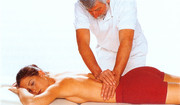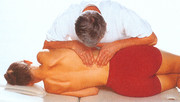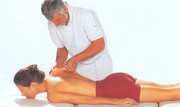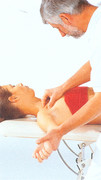 |
Thoracic spine |
|
 |

 |
Manual - Manual stretching |
 |
 |
 |
Rotation of the back extensors (Autochthonous extensor):
|
|
|
a) The spinal acanthi are palpated with the thumb and the ball of the thumb and the muscle fibers running parallel to the back extensor muscles are then pushed away from the acanthi to apply a u-shaped pre-tensioning of the muscles. To stretch, the pressure is increased with the second hand using the thumb itself or, for wider ranging stretching, the ball of the thumb.
|
|
b) With the patient in a lateral position with knees partially flexed, the long back extensors are palpated with the fingertips. The therapist pulls the muscles towards him/her and pre-tensions them in a u-shaped manner. To stretch, the therapist pushes on the shoulder girdle and pelvis with the forearms and pushes them apart to separate them from the beginning and attachment of the back extensor.
|
 |
|
 |
Stretching of the lower fixators of the shoulder girdle (Trapezius inferior, rhomboids):
|
|
|
a) The therapist's hands grasp the scapula and apply pressure so that the tip of the shoulder blade is pushed over his/her fingers. To stretch, the right shoulder blade is lifted away from the supporting surface and turned to the right.
|
|
b) By applying pressure from above, the therapist moves the shoulder blade over the second hand. To stretch, the right shoulder blade is turned to the left.
|
 |
|
 |
Stretching of the small chest muscle (Pectoralis minor):
|
|
Stretching of the large chest muscle (Pectoralis major):
|
| The therapist grasps the small pectoral muscle below the collarbone using a pinch grip. S-shaped pre-tensioning is applied by turning the hand. To stretch, the patient's arm is moved laterally.
|
 |
|
The therapist grasps the large pectoral muscle using a pinch grip, either closer to the rib cage or in the shoulder joint area. S-shaped pre-tensioning is applied by turning the hand. To stretch, the arm is moved diagonally upwards.
|
|
|
 |
 |
|
|
|



